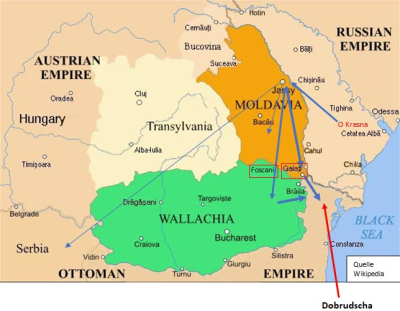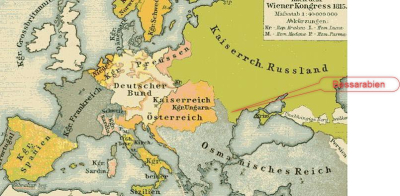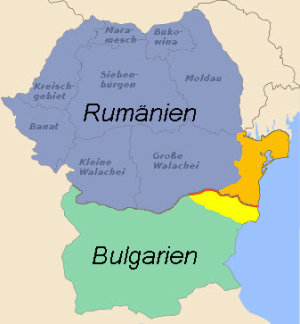_English_
User Tools
Site Tools
Sidebar
Table of Contents
5.3.4 Removal of colonists from Krasna in 1843
This chapter was completely revised by Eduard Volk
and copied here in January 2022.
.
Later, there was again a large group of people who left Krasna.
The 1850 Census lists 16 families who left for foreign countries, but does not say for what reasons or where they left.
Departure of colonists from Krasna in 1843
(Source: Census 1850
- Konrad Hittel (moved away in 1843) Sons: Johannes, Paul
- Michael Arlot (moved away in 1843) Sons: Michael, Anton, Dominik, Johannes
- Joseph Paul (moved away in 1843)
- Joseph Erker (moved away in 1843) Son: Felix
- Michael Milbradt (moved away in 1843) Sons: Matthias, Daniel
- Johann Peter Ternes (moved away in 1843) Sons: Anton, Peter
- Joseph Harte (Garte oder Marte?) (moved away in 1840) Son: Karl
- Wendelin Mohr (moved away in 1843) Sons: Johannes, Anton, Friedrich, Klemens
- Gottfried Dam (moved away in 1843) Stepsons: Nikolaus Weiss, Joseph Weiss
- Peter Bogolowski (moved away in 1843) Son: Martin
- Michael Schnabel (moved away in 1843) Sons: Johannes, Franz, Leopold
- Johann Kuss (moved away in 1843) Son: Peter
- Martin Maas (moved away in 1843)
- Gottlieb Brandt (moved away in 1843) Sons: Martin, Johannes
- Johann Grunwald (moved away in 1843
- Johann Deichert (moved away in 1843)
The reasons of the individual families for their departure may have been different. Z. For example, there were families who did not have their own farmstead in Krasna, perhaps there were also family reasons. In other cases it can be assumed that there were reasons that made it difficult or impossible to manage the farm (e.g. illness, death, but also inadequacy of the owner) or that the colonist life in Krasna was too exhausting for the people.
At that time, even ambitious landlords who did not have adult children and could not afford foreign labor, did not always fulfill their obligation as required by the welfare committee.
In addition, difficult years had preceded (drought, crop failures, epidemics, the earthquake of 1838).
It is therefore understandable that people were looking for ways to improve their living situation. Hans Petri writes about this1) “An emergency situation caused by a lack of land, which had been significantly aggravated by economic setbacks of various kinds, such as harvest failures, cattle deaths and locust infestations, forced numerous German farmers, mostly of younger age, to leave their residences in Bessarabia and in the Cherson governorate and to go on the move in search of land, without, however, knowing at first where such land could be found.”.
Leaving the settlement and settling in another part of the Russian Empire (possibly in the city, where various trades could be practiced) would have resulted in the loss of colonist status and mandatory military service. Therefore, many chose to resettle across the border. It is necessary to remember that at that time “foreign country” from the point of view of Bessarabia could be practically only towards the west, because towards the east there was nothing but the Empire of Russia for thousands of kilometers.
Accordingly, the Russian authorities issued exit documents. The border crossing was allowed to resettlers via Sculeni near Jassi2) given to return to Germany.
Russian authorities probably assumed that colonists originating from German regions would move back to German areas. This may have happened in individual cases, but for the vast majority what Prokopowitsch writes was true 3). “But since these poor people, after so many years, could no longer hope to find a piece of land to cultivate in their original fatherland, they decided to move to the Danube … in order to receive … living quarters and land for cultivation.”
The migration from Bessarabia was not directed by the authorities and therefore unplanned. Migration groups were formed on their own initiative. Mostly single families or small groups traveled, who followed the “word of mouth”, looked around here and there and searched for a place worth settling on their migration. There was no fixed destination to be reached by the shortest route. It was a matter of searching for land and finding it, no matter where.
Their search led the people
- to the Moldau,
- the Walachai (Muntenia),
- to the right side of the Danube (Bulgaria, to the Dobruja4) ),
- to the steppes of Hungary and Serbia.
After the emigrants arrived in Jassi, those who did not want to stay in Moldavia moved to Wallachia via Foscani and Galatz, and partly from there.
It is not known how many groups set out. Petri5) has been able to examine seven groups in more detail, helped essentially by Protestant church book entries6):
- The first group spent the winter of 1841/1842 near Braila and settled in Akpunar in Dobruja in the spring of 1842.
- The second group of Catholic colonists coming from colonies near Odessa founded Malkoch in Dobruja in 1843.
- A third group can be identified at the end of 1842 near Jassi
- One group first came as far as Serbia, but settled in Dobruja a few years later
- One group came to Bucharest in 1842, and from there a part went to Jakobstal via Braila a little later (see 7.)
- One group arrived at an estate near Plojescht (Ploieşti), and from there a part went to Jakobstal.
- Several families from Groups Six and Seven settled first in Jakobstal, which had been settled several years earlier by colonists from Russia; from there families later went to Dobruja.
In none of the groups described by Petri are Krasna colonists mentioned (but emigrants come from all the Protestant neighboring villages of Krasna).
As can be seen, many families from the above seven groups ended up, often after long searching and wandering, in Dobruja, which was then under Ottoman rule.
- Two of the groups immediately turned to Dobruja:
- The first group spent the winter of 1841/1842 near Braila and settled in the spring of 1842 Akpunar in Dobruja.
- The second group -catholic colonists coming from colonies near Odessa- founded Malkoch in Dobruja in 1843.
- From the other groups, many went to Dobrogea a little later.
This shows that Dobruja was the center of the final settlement of the migrants from Bessarabia.

Picture shows: The Principalities of Moldavia and Wallachia and the former Grand Duchy of Transylvania (18th century Habsburg crown land). The map shows the lands at the time of the Third Peace of Paris in 1856 and their unification in 1861 as the nucleus of the state of Romania
Image source.: Anonimu at the English Wikipedia
We do not know in detail where the Krasna emigrants stayed. But they too - like the emigrants from the other Bessarabian colonies - will have searched for land in Moldavia, Wallachia and on the right bank of the Danube. There are indications for some of them.
We have seen above that emigrants who did not want to stay in Moldavia moved on via Foscani and Galatz.
Only for those who went via Galatz there is so far a document which mentions emigrants from Bessarabia by name.
On May 11, 1843, the Austrian consul in Galatz wrote to Vienna7): “In February and March, German colonists who had subsequently emigrated from Bessarabia arrived in Galatz, who also crossed the Danube and joined the earlier colonists”.
Enclosed with this letter was a directory naming five Krasna emigrant families who arrived in Galatz on February 21 and March 07, 1843, respectively.
Here follows an excerpt from the directory with the names of the Krasnaers.
Directory of the German colonists who emigrated from the region of Akierman in the Russian Governorate of Bessarabia and arrived in Gallatz“.
| Number of family heads | name and surname | ancestry | husband | wife | children | siblings |
|---|---|---|---|---|---|---|
| At 21. Februar 1843 | ||||||
| 1 | Martin Maas | From Preussen | 1 | 1 | 1 | 3 |
| 1 | Peter Bogolowski | From Preussen | 1 | 1 | 5 | 7 |
| At 7. März 1843 | ||||||
| 1 | Gottfried Brand | From Preussen | 1 | 1 | 5 | 7 |
| At 21. Februar 1843 | ||||||
| 1 | Konrad Gittel | From the Königreich Baiern | 1 | 1 | 6 | 8 |
| 1 | Wendel Mohr | From Galizien | 1 | 1 | 4 | 6 |
Possibly, other Krasna people went through Galatz. We do not know. But at least it is documented that a good 31% of those who moved away from Krasna in 1843 took the route via Galatz.
Below are the documents with information about these families in relation to their departure placed next to each other:
| Krasna Revisionliste (Census) 1835 | Removal of Krasna to foreign lands around the year 1843 (source: Census 1850) | “Directory colonists from Bessarabia arrived in Galatz” |
|---|---|---|
| Konrad Hittel 38 - Wife: Susanna 28 Sons: Jakob 16, Johann 14, Paul ½ Daughter: Elisabetha 7 | Konrad Hittel (moved abroad in 1843) | Am 21. Februar 1843 Konrad (G)Hittel Mann, Frau, sechs Kinder Mit seiner 2. Frau Susanna Novak hatte er sechs Kinder |
| Wendelin Mohr 37 - Wife: Maria Eva 34 Sons: Johann 16, Anton 8, Frederik 4, Klemens 2 Daughter: Magdalena 6 | Wendelin Mohr (moved abroad in 1843) | Am 21. Februar 1843 Wendel Mor Mann, Frau, vier Kinder Das Paar hatte vier Söhne, die beiden älteren Kinder blieben in Krasna |
| Peter Bogolowski 31 - Wife: Katharina 27 Son: Martin 5 Daughters: Viktoria 2, Helena ¼ | Peter Bogolowski (moved abroad in 1843) | Am 21. Februar 1843 Peter Bogolowski Mann, Frau, fünf Kinder Lt. OFB Krasna stimmt Kinderzahl nicht |
| Martin Maas 53 - Wife: Katharina 50 Daughter: Anna 12 | Martin Maas (moved abroad in 1843) | Am 21. Februar 1843 Martin Maas Mann, Frau, ein Kind. Lt. OFB Krasna alle dort bekannten Kinder in Krasna geblieben Ferdinand Maas (Sohn von Georg Maas) kommt in Dobudscha vor |
| Gottfried Brandt 33 - Wife: Sophia 31 Sons: Martin 9, Johann 7 Daughter: Elisabetha | Gottlieb Brandt (moved abroad in 1843) | Am 07. März 1843 Gottfried Brand Mann, Frau, fünf Kinder Lt OFB Krasna hatte Paar fünf Kinder. |
How they moved on from Galatz is not known. Even the Austrian consul in Galatz did not know anything about their whereabouts; he wrote: “According to received news, since the month of April, all of the aforementioned colonists have gone across the Danube and have dispersed in Wallachia in such a way that they cannot be found.”.
It is quite possible that the mentioned Krasna people - or some of them - came across in Galatz or later on the group that Malkoch founded in Dobrudsche (groups 2 at Petri). In any case, three families appear there in the first church records. How and when they got there could not be found out yet.
In Malkoch the first 20 to 25 German families arrived in 1843. They came from the Catholic colonies of Kherson Governorate8), from Josephsthal, Mannheim, Alsace, Landau, Katharinenthal, “on the whole from 10 different villages”9). Their way had taken them
- through Bessarabia and
- the Moldau to Focsani and
- from there through Wallachia to Calarasi. Near this town they had settled in a village Dschuroi(?) and stayed there for one and a half year.
- Then they left again and arrived in Dobruja via Galatz.
Since at that time it was very important to live together with religiously like-minded people, there is much to suggest that our Krasna people came to Malkoch between 1843 -1846. In any case, the community list kept from 1847 onwards shows the Krasnaer names Hittel, Brandt, Bogolowski, which appear in the above-mentioned list of emigrants who moved via Galatz.
Traeger : „Der erste Catalogo dello stato dell’anime esistenti in Malkoc 184710), 1novembre, führt 28 Familien mit 134 Seelen an. Sie tragen folgende Namen: Heret (Ehret), Kunzler, Mak (Mach, Mack), Hittl, Baumstergk (Baumstark), Anghat (Ankert), Hek (Heck), Kres (Gres, Greß), Rifll (Riffel), Kooset (Kost), Hoffart, Klaaen (Klain, Klein). Prendel, Frank, Kiffer (Kiefer), Vaidaman (Weidemann), Drescher, Kokert (Gugert), Book, Scmit (Schmidt), Bruker (Brücker), Haispelader. Further lists of inhabitants from the following years are not found in the book. But we can see from the other entries, how the village has grown gradually by 1861 by fresh influx. Beside the old family names new ones appear: Vahner, Screder (Schroeder), Brand, Krieger, Führer, Martin, Weiß, Sießler (Schüßler), Türk, Mehle (Melle), Keim, Geiß. Tuchserer (Tuchscheerer), Hink, Waibl u. a., auch ein polonista Bukalovski (Bobolovski).“
In the 1870s, more Krasna colonists moved to Dobrudja. One group of them founded Karamurat.
Link to the places:
Source: Vasile Docea: German Immigrants and Colonists in Romania (the 19th Century) Colonization Attempts in Moldova and Wallachia in 1842-1843
See discussions, stats, and author profiles for this publication at:
German Emigrants and Colonists in Romania in the 19th Century
Conference Paper - December 2013 DOI: 10.13140/RG.2.1.4584.8404
Süddeutsches Archiv, IV. Band, 1961, pp. 58 - 69
Südost-Forschungen 7, 1942 - IOS Regensburg, ' SOF ' SOF1942
Süddeutsches Archiv, IV. Band, 1961, p. 58 - 69
Original erschienen Stuttgart 1922 Ausland und Heimat Verlags-Aktiengesellschaft\ Heinz-Jürgen Oertel, Halle (Saale) 2012
The text is the unchanged reprint of the original work by Paul Traeger
Traeger p. 45: Catholic colonies of the Kherson governorate, from Josephsthal, Mannheim, Alsace, Landau, Katharinenthal, “on the whole from 10 different villages.”



